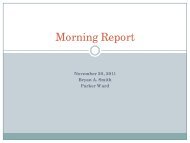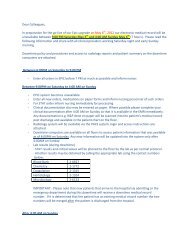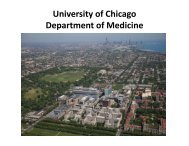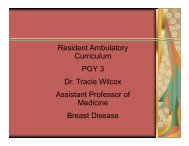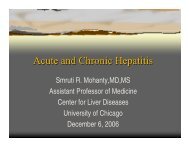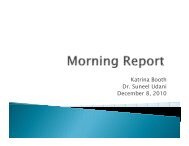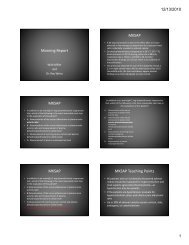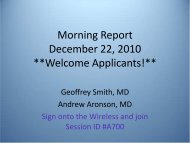Morning Report
Morning Report
Morning Report
You also want an ePaper? Increase the reach of your titles
YUMPU automatically turns print PDFs into web optimized ePapers that Google loves.
Morbidity & Mortality<br />
Conference<br />
Kate Grossman<br />
Todd Barrett<br />
12/16/10
Chief Complaint<br />
• 21 yo F w/h/o SLE (s/p Autologous Stem Cell<br />
Transplant in 2009) and ESRD on PD admitted to<br />
General Medicine with chest pain, lower back pain,<br />
abdominal pain, nausea and vomiting.
History of Present<br />
Illness<br />
• Chest pain – sharp, no radiation, left sided, x1 day,<br />
non-exertional, non-pleuritic, no SOB, no fevers, no<br />
cough<br />
• Lower back pain x3 weeks, worsening, no sxs<br />
concerning for cord compression<br />
• N/V – chronic problem x1 year (since SCT), usually<br />
has emesis 3-4 x/week, worse in last week, last few<br />
days states is intolerant to PO fluids and solids<br />
• Never previously worked up.
Past medical History<br />
• SLE<br />
• Lupus Nephritis ESRD<br />
• Lupus Cerebritis h/o Seizures<br />
• s/p Autologous SCT 8/09 no flares since<br />
• ESRD<br />
• Peritoneal Dialysis<br />
• h/o Hemodialysis – L UE AV fistula<br />
• HTN<br />
• Right IJ Thrombus – 6/2010
Past Surgical History<br />
• Appendectomy<br />
• AV Fistula<br />
• Multiple Central Lines<br />
• Peritoneal Dialysis Catheter<br />
placement<br />
Social/Family<br />
History<br />
• No smoking<br />
• No alcohol<br />
• No illicits<br />
• Incarcerated in past for “a<br />
misunderstanding”<br />
• Aunt w/SLE
Medications<br />
• Prednisone 5mg po daily<br />
• Plaquenil 200mg po bid<br />
• Coumadin 5mg po daily<br />
• Lisinopril 5mg po daily<br />
• Amlodipine 10mg po daily<br />
• Metoprolol 50mg po tid<br />
• Lasix 80mg po daily<br />
• Acyclovir 400mg po bid<br />
• CellCept<br />
Allergies<br />
• Hydromorphone<br />
• ? h/o HIT – was HIT<br />
positive on past admission,<br />
but SRA negative and repeat<br />
HIT negative – still being<br />
documented as having had<br />
HIT.
Physical Exam<br />
• 36.7, 99, 15, 175/119, 97% RA<br />
• HEENT – PERRLA, no oral ulcers, no thrush, no LAD,<br />
oropharynx clear, +moon facies<br />
• CV – RRR, no M/R/G, no S3/S4, 2+ periph pulses<br />
• Resp – dec. BS at left base<br />
• GI – diffuse abd tenderness, no rebound, no guarding, PD<br />
dressing C/D/I, +abd collateral vessels noted<br />
• MSK – no LE edema, bony and soft tissue tenderness to palpation<br />
(lower back>upper), no point tenderness<br />
• Skin – no rashes, straiae over upper arms
4.5<br />
N: 38%<br />
L: 45%<br />
M: 12%<br />
11.1<br />
220<br />
CK 76 63 55<br />
Trop
EKG
Gens Admission<br />
• Thoughts on further work up? Further management?
Hospital Course<br />
• 10/18/10 8pm – Seen in ED<br />
• 10/19/10 am – admitted to general medicine Taken to<br />
floor at 2:20pm<br />
• 10/19/10 3:20pm – Peritoneal Dialysis started<br />
• Peritoneal Fluid sent for Culture, Cell count, Gram Stain<br />
• Culture negative<br />
• 20 WBC<br />
• 10/19/10 6:42pm – patient ruled out w/3 sets negative<br />
enzymes, no EKG changes, symptoms resolved.<br />
• Decided to keep patient in-house until morning so she can be<br />
seen by Rheumatology<br />
• Patient eating dinner
Hospital Course (cont)<br />
• 10/19/10 7:05pm – pt unresponsive<br />
and pulseless - Dr. Cart called
Dr. Cart Called<br />
• Upon presentation the patient was<br />
unresponsive, pulseless, partially connected<br />
to the floor cardiac monitor<br />
• Per report the patient was alert and<br />
responsive 5 minutes before being found<br />
unconscious<br />
• Patient was connected to the peritoneal<br />
dialysis machine and nursing staff did not<br />
know how to disconnect it.
Dr. Cart Called<br />
• Initial rhythm was identified as Vfib<br />
• CPR started<br />
• Pads from Dr. Cart Pack were connected<br />
and shock was delivered.<br />
• Leads kept being removed from the patient<br />
and rhythm was monitored on floor pack
Dr. Cart<br />
• Patient was intubated and end tidal CO2 was >25<br />
in following 2 minutes. Leads were connected.<br />
• Pt identified as having lupus and on dialysis.<br />
• Epi x 2, Magnesium, Calcium, and Bicarb were<br />
given over the course of 4 minutes.<br />
• EKG from admit showed prolonged QT<br />
• Surgery inserted right femoral central line
Dr. Cart<br />
• Patient had spontaneous return to circulation<br />
• There were spontaneous movements noted and<br />
sedation was ordered for the patient<br />
• Code labs started to arrive…
Ventricular Fibrillation<br />
Differential<br />
Viskin, S and Belhassen, B, American Heart Journal, Sept. 1990, 260-271<br />
• Myocardial Ischemia<br />
• Electrolyte abnormalities including hyperkalemia and<br />
hypomag<br />
• Prolonged QT<br />
• Structural valvular disease<br />
• Reentrant loops including Wolf Parkinson White syndrome<br />
• Brugada Syndrome<br />
• Myocarditis<br />
• Overdose of cardiac toxic medications<br />
• Trauma
Disposition<br />
• Patient was hospitalized with multiple chronic<br />
medical conditions and the MICU senior was<br />
present at the code, so the decision was made to<br />
admit the patient to the medical ICU with the<br />
presumed cause of the arrest to be long QT with<br />
electolyte abnormalites.
Role of Cardiac Cath in In<br />
Hospital Vfib Arrest<br />
• American College of Cardiology guidelines for<br />
non-STEMI do not address post-arrest survivors.<br />
• ACLS does not include any recommendations for<br />
post Vfib or Vtach arrest to receive urgent cardiac<br />
catheterization<br />
• Some recent evidence indicates cardiac<br />
catheterization in underutilized and may improve<br />
survival.<br />
• No randomized controlled trials are present for<br />
in hospital arrest
Cardiac catheterizations are under utilized after in-hospital<br />
cardiac arrest.<br />
R. M. Merchant et al.<br />
Journal of Resuscitation (2008) 79, 398-403<br />
• 1035 inpatient cardiac arrests were analyzed<br />
• 427 had return of spontaneous circulation<br />
• 110 initial rhythm was Vfib<br />
• 80 did not receive early cardiac catheterization<br />
• 30 received early catheterization<br />
• Early catheterization was defined as a cath within 24<br />
hours of arrest<br />
• Average age was approximately 65
Cath Group<br />
• 13/30 = 43% had STEMI or new LBBB on EKG<br />
• All of these patients had clinically significant CAD and<br />
92% had successful PCI<br />
• 17/30 = 57% went to cath lab without STEMI or LBBB<br />
• Of these patients 6 (35%) had obstructive CAD requiring<br />
intervention
Outcomes<br />
Outcomes and Limitations<br />
• Patients receiving cardiac catheterization were more likely to survive that those who<br />
did not receive catheterization<br />
• No cath survival = 54%<br />
• Cath survival = 80%<br />
Limitations<br />
• This was a retrospective chart review with no discussion about clinical reasoning for<br />
decisions<br />
• Small patient numbers and the average age was 67 (who went to cath)<br />
• It is unknown if the people receiving PCI needed urgent intervention or if similar<br />
outcomes would have resulted with a diagnostic cath at a future date
Niemann, JT. et al. Is all ventricular fibrillation the same? A<br />
comparison of ischemically induced with electrically induced<br />
ventricular fibrillation in a porcine cardiac arrest and<br />
resuscitation model. Critical Care Medicine. 2007 May; 35(5); 1356-61<br />
• The purpose: Determine if ischemic induction of ventricular fibrillation in<br />
swine followed by standard ACLS would result in short term outcomes<br />
similar to out of hospital arrest outcomes<br />
• 40 domestic swine of both genders<br />
• No difference in number of shocks required to to initially terminate rhythm<br />
• electric 1.9 and ischemic 2.4<br />
• Total shocks for spontaneous circulation<br />
• electric 2.4 and ischemic 9.4 p
MICU Transfer<br />
• Transferred to MICU intubated.
MICU Differential Dx<br />
• Arrhythmia - Prolonged QT, Hypokalemia, Reglan, Zofran,<br />
Plaquenil<br />
• PE - ? Hypercoaguable w/recent R IJ Thrombus, ?HIT, but<br />
was therapeutic on Coumadin<br />
• Ischemia – main risk factor – h/o SLE<br />
• Intracerebral bleed – decerebrate posturing after code<br />
• Seizure d/o – h/o seizures, ?sz activity in ER nursing note<br />
• Sepsis – dialysis pt, on prednisone and plaquenil – from UTI<br />
vs bacteremia vs peritonitis
First 12 hrs in MICU<br />
• Hypotensive initially – 90s/60s improved with 1L<br />
IVF bolus, lightening of sedation, and stress dose<br />
steroids.<br />
• h/o Pleural Effusion – w/hypotension considered<br />
Pericardial Effusion Bedside Resident Echo (from<br />
Echo study) – no pericardial effusion w/good gross<br />
function<br />
• Concern for Ischemia – very rapid ROSC, post-code<br />
enzymes sent, EKG showed sinus tach<br />
CK 94 139 178<br />
MB-RI --- 3.5 2.2<br />
Troponin T 0.5 1.37 0.9
First 12 hrs in MICU<br />
(cont)<br />
• S/p V-Fib Arrest – discussed cooling pt – but moving<br />
all extremities and responsive once settled in D3.<br />
• Hyperreflexic w/muscle fasciculations (left UE and<br />
LE> right) with decerebrate posturing Ativan given<br />
x2, STAT bedside Head CT (no bleed, no edema),<br />
Neuro evaluated, Keppra started<br />
• Concern for peritonitis initially w/hypotension <br />
Broad spectrum antibiotics initiated w/plan for IJ line<br />
for CVP monitoring and SvO2
Therapeutic Hypothermia<br />
Nolan, JP et al. Therapeutic Hypothermia After Cardiac<br />
Arrest International Liaison Committee on Resuscitation,<br />
Circulation Supplement 2003<br />
• ILCOR recommendations<br />
• Unconscious adult patients with spontaneous circulation after out of<br />
hospital arrest should be cooled to 32-34 degrees C for 12-24 hours when<br />
the initial rhythm is Vfib. Level I evidence<br />
• Such cooling may also be beneficial for other rhythms or in-hospital<br />
arrest. Level 4 evidence<br />
• OUR PATIENT HAD SPONTANEOUS MOVEMENT
Hypothermia Exclusion<br />
Criteria<br />
• Severe cardiogenic shock<br />
• Life-threatening arrhythmias<br />
• Pregnant patients<br />
• primary coagulopathy<br />
• Thombolytics are NOT exclusion criteria. They were all<br />
included in the European trials
Central<br />
Line<br />
Placement
Blood Gas<br />
• 7.45/34/196/24/97.5%
Blood gases<br />
Line R Radial<br />
Art Line<br />
R IJ (?) TLC Venous Stick<br />
pH 7.48 7.45 7.4<br />
pCO2 30 34 38<br />
pO2 305 196 53<br />
HCO3 22 24 24<br />
SO2 98% 97.5% 87%
Cardiac Cath<br />
• Left main - large caliber vessel which gives off the LAD and<br />
LCx arteries without significant disease.<br />
• Left anterior descending artery - large caliber vessel which<br />
gives off diagonal and septal perforator branches <br />
without significant disease.<br />
• Left circumflex - dominant vessel whichgives off several<br />
obtuse marginal branches and a posterior descending artery<br />
without significant disease.<br />
• Right coronary artery - small nondominant vessel which<br />
gives off very small acute marginal branches without<br />
significant disease. LVEDP 13 mmHg.
Indications foR ICD
InDications for ICD<br />
Therapy<br />
• Class I Recommendation - Cardiac arrest due to<br />
ventricular fibrillation (VF) or VT not due to a transient<br />
or reversible cause. (Level of Evidence: A)<br />
• Class IIb Recommendation – Familial or inherited<br />
conditions with a high risk for life-threatening ventricular<br />
tachyarrhythmias such as long-QT syndrome or<br />
hypertrophic cardiomyopathy. (Level of Evidence: B)<br />
• Class III Recommendation - Ventricular tachyarrhythmias<br />
due to a transient or reversible disorder (eg, AMI, electrolyte<br />
imbalance, drugs, or trauma) when correction of the<br />
disorder is considered feasible and likely to substantially<br />
reduce the risk of recurrent arrhythmia. (Level of Evidence:<br />
B)<br />
Circulation: ACC/AHA/NASPE 2002 Guideline Update for Implantation<br />
of Cardiac Pacemakers and Antiarrhythmia Devices.<br />
ACC/AHA/HRS 2008 Guidelines for Device-Based Therapy of<br />
Cardiac Rhythm Abnormalities: Executive Summary
Support for icd<br />
• Survivors of ventricular<br />
tachyarrhythmias due to a transient or<br />
reversible disorder have a high recurrence<br />
rate of lethal cardiac events.<br />
Resuscitation. Vol 54. Issue 3. 237-243.
Our patient<br />
• Discharged home with f/u w/EP.<br />
• Since V-Fib arrest thought 2/2 Hypokalemia<br />
(reversible) – set up for outpatient EP study and ICD<br />
Placement.
References<br />
• Merchant, Abella, et al. Cardiac Catheterization is underutilized after in-hospital<br />
cardiac arrest. Resuscitation. 2008. Vol 79: 398-403<br />
• Nadkarni, Larkin et al. First Documented Rhythm and Clinical Outcome from inhospital<br />
cardiac arrest among children and adults. JAMA. 2006. 295:50-57.<br />
• Brembilla-Perrot, Miljoen, et al. Causes and Prognosis of Cardiac Arrest in a<br />
population admitted to a general hospital; a diagnostic and therapeutic problem.<br />
Resuscitation 2003. Vol 58: 319-327.<br />
• AVID Investigators, Wyse, Friedman et al. Life-Threatening ventricular arrhythmias due<br />
to transient or correctable causes: high risk for death in follow-up. Journal of American<br />
College of Cardiology. 2001. Vol 38: 1718-1724.<br />
• ACC/AHA/NASPE 2002 Guideline Update for Implantation of Cardiac Pacemakers<br />
and Antiarrhythmia Devices: Summary Article. Circulation. 2002. Vol 106: 2145.<br />
• ACC/AHA/HRS 2008 Guidelines for Device-Based Therapy of Cardiac Rhythm<br />
Abnormalities: Executive Summary. Journal of American College of Cardiology. 2008.<br />
Vol 51: 2085-2105.



